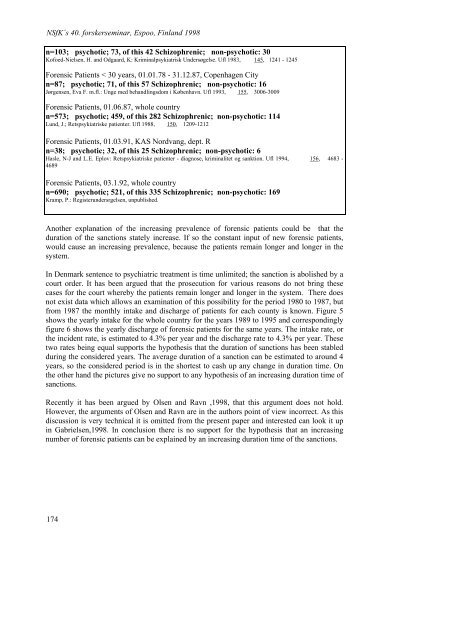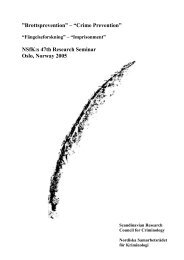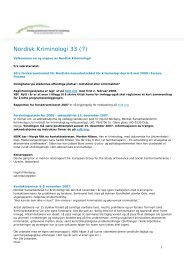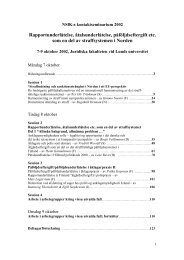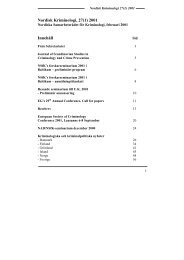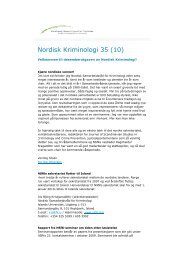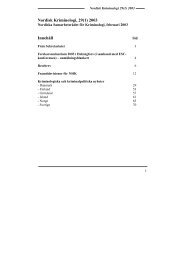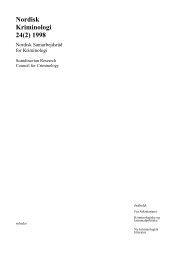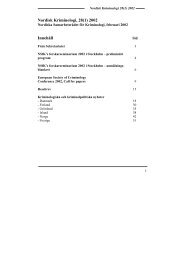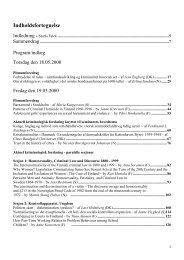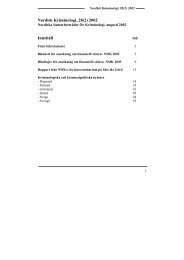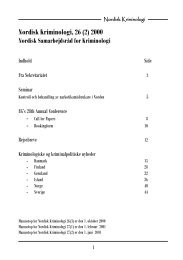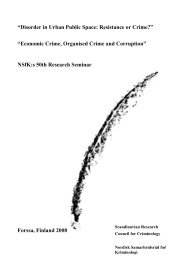Organised Crime & Crime Prevention - what works? - Scandinavian ...
Organised Crime & Crime Prevention - what works? - Scandinavian ...
Organised Crime & Crime Prevention - what works? - Scandinavian ...
You also want an ePaper? Increase the reach of your titles
YUMPU automatically turns print PDFs into web optimized ePapers that Google loves.
NSfK´s 40. forskerseminar, Espoo, Finland 1998<br />
n=103; psychotic; 73, of this 42 Schizophrenic; non-psychotic: 30<br />
Kofoed-Nielsen, H. and Odgaard, K: Kriminalpsykiatrisk Undersøgelse. Ufl 1983, 145, 1241 - 1245<br />
Forensic Patients < 30 years, 01.01.78 - 31.12.87, Copenhagen City<br />
n=87; psychotic; 71, of this 57 Schizophrenic; non-psychotic: 16<br />
Jørgensen, Eva F. m.fl.: Unge med behandlingsdom i København. Ufl 1993, 155, 3006-3009<br />
Forensic Patients, 01.06.87, whole country<br />
n=573; psychotic; 459, of this 282 Schizophrenic; non-psychotic: 114<br />
Lund, J.; Retspsykiatriske patienter. Ufl 1988, 150, 1209-1212<br />
Forensic Patients, 01.03.91, KAS Nordvang, dept. R<br />
n=38; psychotic; 32, of this 25 Schizophrenic; non-psychotic: 6<br />
Hasle, N-J and L.E. Eplov: Retspsykiatriske patienter - diagnose, kriminalitet og sanktion. Ufl 1994, 156, 4683 -<br />
4689<br />
Forensic Patients, 03.1.92, whole country<br />
n=690; psychotic; 521, of this 335 Schizophrenic; non-psychotic: 169<br />
Kramp, P.: Registerundersrgelsen, unpublished.<br />
Another explanation of the increasing prevalence of forensic patients could be that the<br />
duration of the sanctions stately increase. If so the constant input of new forensic patients,<br />
would cause an increasing prevalence, because the patients remain longer and longer in the<br />
system.<br />
In Denmark sentence to psychiatric treatment is time unlimited; the sanction is abolished by a<br />
court order. It has been argued that the prosecution for various reasons do not bring these<br />
cases for the court whereby the patients remain longer and longer in the system. There does<br />
not exist data which allows an examination of this possibility for the period 1980 to 1987, but<br />
from 1987 the monthly intake and discharge of patients for each county is known. Figure 5<br />
shows the yearly intake for the whole country for the years 1989 to 1995 and correspondingly<br />
figure 6 shows the yearly discharge of forensic patients for the same years. The intake rate, or<br />
the incident rate, is estimated to 4.3% per year and the discharge rate to 4.3% per year. These<br />
two rates being equal supports the hypothesis that the duration of sanctions has been stabled<br />
during the considered years. The average duration of a sanction can be estimated to around 4<br />
years, so the considered period is in the shortest to cash up any change in duration time. On<br />
the other hand the pictures give no support to any hypothesis of an increasing duration time of<br />
sanctions.<br />
Recently it has been argued by Olsen and Ravn ,1998, that this argument does not hold.<br />
However, the arguments of Olsen and Ravn are in the authors point of view incorrect. As this<br />
discussion is very technical it is omitted from the present paper and interested can look it up<br />
in Gabrielsen,1998. In conclusion there is no support for the hypothesis that an increasing<br />
number of forensic patients can be explained by an increasing duration time of the sanctions.<br />
174


